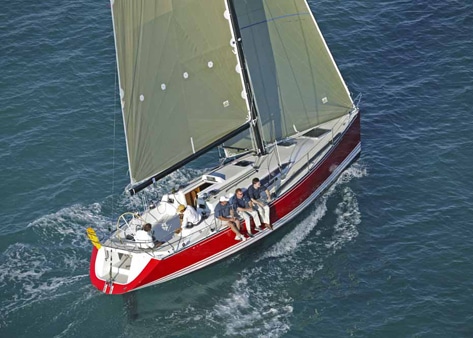
Rounding the corner at Gray’s Reef during last summer’s Chicago-Mackinac race, I was in the aft cabin of the C&C 115 prototype when shouts from my mates in the cockpit roused me from what was never destined to be a peaceful slumber.
“Thirteen!” cried the helmsman, his eyes on the speedo. On a boat with 33 feet of waterline, that’s a lucky number, indeed. I rolled out and dashed to the deck for the exhilarating run down the Straits of Mackinac to a podium finish.
It was one of several very happy moments aboard the model that would go on to earn accolades as Sailing World’s Overall Boat of the Year for 2006 as well as Best Racer/Cruiser.
C&C Yachts was founded in 1969 by George Cuthbertson and George Cassian in Niagara-on-the-Lake, Ontario, Canada. But a fire in 1994 all but ended C&C’s life in Ontario, and in 1998 the folks behind Tartan Yachts bought the name and several molds. From that moment on, C&C’s fate has been intertwined with that of Tim Jackett, the head designer who virtually grew up with Tartan Yachts. Like other recent models, the C&C 115 is his brainchild.
While both Tartan and C&C have historical claims to both sides of the racer/cruiser divide, since coming together under one umbrella, the two lines have been deliberately distinguished. Jackett has tailored the Tartan line toward the cruising end of the spectrum and the C&C more toward the performance end.
Secrets to C&C’s success lie in several strategic choices. The most important of these was the decision to build epoxy boats on a production scale. Epoxy is tricky to work with, but done right, it’s flat-out the best resin with which to build boats: stronger, stiffer, and more resistant to osmosis than either polyester or vinylester. Impregnated, vacuum-bagged, and post-cured in a sandwich with unidirectional E-glass and Core-cell linear-polyurethane- foam coring, these boats start with a top-notch structure. C&C offers four models (the 99, the 110, the 115, and the 121), and Jackett expects to build 40 units of the 115 this year alone.
Another strategic choice was to invest in a facility that builds carbon spars: Every C&C 115 comes standard with a carbon rig. With a tube that’s half the weight of and stiffer than an equivalent aluminum rig, the 115’s weight aloft is markedly diminished, and the boat is that much more stable. The boat’s righting moment at 1 degree is 1,200 foot-pounds.
All of this adds up to a boat with a light-ship displacement-to-weight ratio of 146 and a sail area-to-displacement ratio of 24, based on a 100-percent mainsail and foretriangle. For those who do plan to bang around the buoys, the boat’s IRC rating is 1.07; the PHRF rating is between 63 and 72. What’s it all mean? Fun, that’s what.
Accommodations are simple and elegant–nothing stripped-out here–with a double berth in each end and saloon settees that work as singles. The interior joiner work is finished with a pleasing cherry. A 28-horsepower Yanmar with saildrive quietly delivers ample power.
All in all, you’d be comfortable to take this boat anchoring, but you’d be thrilled to take it sailing.
Tim Murphy is Cruising World’s executive editor.
C&C 115
LOA 37′ 9″ (11.50 m.)
LWL 33′ 0″ (10.06 m.)
Beam 11′ 11″ (3.63 m.)
Draft 6′ 8″ (2.03 m.)
Sail Area (100%) 781 sq. ft. (73 sq. m.)
Displacement 11,800 lb. (5,352 kg.)
Water 70 gal. (265 l.)
Fuel 26 gal. (98 l.)
Engine 28-hp. Yanmar with saildrive
Designer Tim Jackett
Sailaway Price $215,000
C&C Yachts
(440) 357-7223
www.c-cyachts.com








